“Magnetar (mag·ne·tar). Noun – from the field of astronomy. A magnetar is a type of neutron star. A neutron star is created when an extremely large star, whose mass is 10 – 25 times that of our sun, enters a supernova event and is crushed into an object with a diameter of only ~20 kilometers / 12 miles. That supernova event caused the crushed star’s subatomic particles, its protons and electrons, to be converted into atomic neutrons, resulting in the neutron star’s hyper-extreme density. A magnetar is type of neutron star whose spin, temperature and strength of its original magnetic field creates a dynamo mechanism that converts heat and rotational energy into magnetic energy of colossal strength, well over a trillion times more powerful than that of the Earth.”
Executive summary: A magnetar is the most powerful magnet in the cosmos.

OK, so I can hear you now: “Thanks, Dr. Neil deGrasse Tyson, for the astronomy lesson, but what does this have to do with the new Winterblade Factor Batch 4 knife?”
Well, my children, I’m drawing an analogy between the most colossal magnetic object in the cosmos to the Winterblade Factor B4, the most colossal magnetic pocketknife in the pocketknife cosmos. Get it? No? Well, read on, dear reader. You will.
TL;DR
The Batch 4 version of the Factor, the flagship knife in Winterblade’s collection of cleverly designed and engineered knives and tools, is the latest upgrade to its most popular line of knives. The B4 release, whose 1,500+ preorders are already sold out, offered 13 specific configuration variants of blade steels and finishes; titanium handle texturing & finish colors; titanium pocket clip finish colors and Timascus accents.
All Factor B4 knives now have dual, customizable strength detent magnets; a PVD-coated titanium Flip Lever with a completely redesigned front descending arm; and a redesigned, fully-rounded and deeper finger choil, all of which work in tandem to significantly improve the Flip Lever’s blade opening performance. Magnacut has replaced M390 as the default blade steel, and coated blades now exclusively come in DLC.
In addition, while it’s not a promised feature, with the sample I reviewed, there is a clear, distinctive bell-like “ting” when I open the blade. I was told by Bryan Winters, the founder, engineer and knife designer of Winterblade, that while not all Factor B4 knives will have this feature, many (if not most) will. I was lucky enough to get one to review with a delightful, singing blade!
The February 2025 Factor B4 preorders are expected to ship later this summer, although Bryan told me that due to the very large number of orders received, the likely ship date could be as late as October. It’s in the hands of Bestech now.
If you have the Factor B3 version, you had to carefully consider whether the new features of the B4 added up to the need for an upgrade. However, if you had even earlier versions (B1 or B2) of the Factor (or never had one before!), the Factor B4 is a super-sweet piece of knife design and engineering, not to mention top quality manufacturing. If Winterblade gets the opportunity and offers additional, limited drops of the B4s later on (no promises, but unexpected things could happen!), definitely give this knife a close look. It’s a true gem.
Pros
- New Magnacut blade steel
- The Laser Zebra handle design is a PVD finish with laser-etched swirls and loops – really cool!
- The improved (stronger & customizable), dual magnet-driven detent
- The opening snap of the resigned Flip Lever is much improved over the B3 version
- Timascus pocket clip and pivot collar!
- Much appreciated conversion of the captive pivot to using a standard T8 socket from a proprietary disassembly tool on the B3
- The super-fidget friendly fun blade that’s easily opened with either a reverse flick or the Flip Lever
- The manufacturing quality of Bestech is clearly evident
- The finger-safe, strong and fun-to-use M-Lock magnetic locking system
- That glorious, singing blade ting (eat your heart out, Herman Knives)!
Cons
- As with previous versions of the Factor (and, in fact, most Winterblade knives), the visual design is striking, substantially different from the typical pocketknife, and some may not care for it
- That laser-cut handle finish of the Laser Zebra feels a bit chalky, reminding me of an old, chalky blackboard, the visceral memory of which still sends shivers up my spine (yes, I went to school back in the 1800s)
- Even though I get that deliciously sweet blade ting most of the time, sometimes I don’t (it apparently depends on how you hold it)
- I wish it were larger, but then again, if it were, then it would be the Severn.
- I’m disappointed that there’s no lanyard hole – Hahahahahah! As if! Ah, I make myself laugh sometimes.
I’ll be transparent here: I am a fan of the Winterblade Factor pocketknife. Is it perfect? No – I have yet to see perfection in a pocketknife, so I will have a lot to say in this review. And I will always be honest and fair in my reviews. But to cut to the chase, the Winterblade Factor B4 is a very impressive pocketknife that I can heartily recommend. Now let’s get into the details.
Tech Specs
Brand | Winterblade |
Website | |
Manufacturer | Bestech |
Origin | Yangjiang, Guangdong, China |
Model Reviewed | Factor Batch 4 (aka B4) |
Designer/Design | Bryan Winters |
Model Launch Year | 2025 |
Style | Folding knife |
Lock Type | Magnetic M-Lock with polished Lock Bracket and G10 Lock Button inlay |
Opening Type | Manual |
Opening Mechanism(s) | 1. Very long, asymmetric obround opening hole slot |
Pivot Type | Captive, decoratively engraved, flat, PVD-coated, milled, stainless steel D pivot with a T8 fastener with pink/purple Timascus pivot collars |
Pivot Mechanism | Caged ceramic ball bearings |
Length Closed | 107.41 mm / 4.229" |
Length Opened | 178.41 mm / 7.024" |
Weight | 122.90 g / 4.335 oz. |
Weight-to-Blade-Length Ratio | 1.61 |
Original Packaging | This loaned, prototype knife came in a black, lined zippered pouch with a black, microfiber cleaning cloth, and an assortment of stickers and fridge magnet. |
MSRP & Retail Price | B4 MSRP: $365 to $495 |
Edge | Plain | |
Shape | Angular, modified sheepsfoot? Wharncliffe? | |
Material | "Mag" (Magnacut, right?) | |
Claimed Hardness HRc | 62 ± 1 | |
Blade Length | 76.13 mm / 2.997" | |
Cutting Edge Length | 64.49 mm / 2.539" | |
Primary Bevel Angle | 3° | |
Original Edge Angle | 19° | |
Height | 32.32 mm / 1.273" | |
Spine Thickness | 3.12 mm / 0.123" | |
Main Bevel Edge Thickness | 0.38 mm / 0.015" | |
Finish | Stonewashed | |
Features | The blade comes in a heavily modified, angular sheepsfoot shape and has an asymmetric (almost pentagonal) obround opening slot and a stonewashed finish. The blade has perfectly symmetrical, evenly ground, edge bevel that has an extremely sharp factory edge. A large finger choil makes a choke-up grip comfortable but diminishes the cutting edge length. | |
Grind | Full, flat grind | |
Swedge | None | |
Fuller | None | |
Jimping | None | |
Blade Markings | Show side: None | |
Sharpening Choil | Across: 20.02 mm / 0.789" | |
On-Blade Opening Assists | Very long, asymmetric obround, opening hole slot | |
Materials | TC4 Titanium (Chinese version of 6AI4V aka Grade 5 Titanium) |
Color | Laser Zebra (laser-etched pattern in PVD coating) |
Scale Thickness (includes liner) | 4.16 mm / 0.164" |
Scale Texture | Smooth with slight, laser-etched powdery texture |
Handle/Scale Features | Flat with angular, sculpted and matching, lightly-beveled edge cuts on both sides with chamfered edges. Features dual lock magnets, in which large Lock Button magnet also serves as closing stop pin, polished steel Lock Bracket which serves as opening blade stop, dual, adjustable-strength detent magnets, and twin, nylon blade centering bumper guides. Scales are PVD-coated with laser-etched finish design and milled for weight reduction. |
Liner Type | 1 nested carbon fiber liner on clip side |
Opening Stop Pin Type | Beveled edge of polished steel Lock Bracket |
Closing Stop Pin Hits Sharpening Choil | Lock Button large magnet |
Handle Length | 107.41 mm / 4.229" |
Blade-to-Handle Ratio | 0.71 |
Closed Knife Handle Height | 40.95 mm / 1.613" |
Handle Thickness | 12.49 mm / 0.492" |
Detent | Dual detent magnet system |
Pivot-Center-to-Open-Knife-Fulcrum | 16.98 mm / 0.669" |
Integral Handle | No |
Backspacing Type | Standoff |
Lanyard Mount | Rear standoff |
Pocket Clip | Milled |
Clip Material | Timascus |
Clip Color & Finish | Pink/Purple Timascus |
Clip Placement | Ambidextrous, tip-up |
Clip Length | 52.20 mm / 2.055" |
Clip Length-to-Handle % | 48.6% |
Clip Features | Low profile, medium deep-carry, wide, flat Timascus clip |
Fasteners | 4 PVD-coated titanium fasteners per side (with another screw for the pocket clip) with T8 sockets |
Who is Bryan Winters, the Founder of Winterblade?
Back when I reviewed the Winterblade Severn, I also wrote about the company founder, Bryan Winters. I have since gotten to know Bryan a bit more and he really lives up to his reputation as one of the nicest people in the knife industry. In all transparency, he sent me the Factor B4 knife I used for this review (he also loaned me his own edition of the Metal Complex / Kunwu Excalibur Reverse Tux integral knife that I recently reviewed!), for which I am grateful. I told Bryan that I would do my standard (meaning honest, technically detailed, and sarcastic) Knife Karen teardown of the Factor B4 for SharperApex, and he still agreed.
I’m not sure what to say about Bryan that hasn’t been said already. He’s a relentlessly creative, engineering-oriented, pocketknife designer who loves to imagine and then build. Think I am a mere obsequious, sycophantic Knife Karen? Au contraire, mon ami. All you need to do to verify my assertions is to browse the numerous posts in the Winterblade account on Instagram. Bryan has posted 400+ images and videos of knives he’s released, but he’s also included a multitude of unreleased prototype designs he hand-built as both folding and fixed blade knives, hand tools, even writing instruments. He’s organized his content into 30+ highlight categories, and I can tell you for a fact that this is not everything he’s done. I have had the privilege to see additional prototype images and videos that further demonstrate his infinite engineering creativity.
In my review of the Winterblade Severn, I called him Dr. Magnet. That’s an apropos moniker, to be sure, but now in retrospect, I think he’s actually the Thomas Edison of the pocketknife industry (Wait! Does anyone else besides me know who Edison is? Sheesh, I am getting old! Edison was a prolific inventor who received 1,093 patents, and who knows how many other of his ideas that were never patented?). I know that Bryan never stops working, designing, engineering, and building his new ideas. He has them in endless supply. Can you tell I am impressed? Yeah. And while I’m not an obsequious sycophant, I am a genuine admirer.
Bryan also has a fun sense of humor. He’s quick with the Dad jokes. He posted a quirky image of himself busy with work. Who else hates thick lenses in their glasses?

I have reason to believe that image was a bit distorted, though (duh! Do you think?). He also posted this image of him attending the wedding of one of his daughters. The original image was a family photo, but out of courtesy to the privacy of his family, I cropped it to only show Bryan. It’s a nice photo.

The History of the Winterblade Factor
The Winterblade Factor pocketknife has served as the company’s flagship product since it was first released back in May 2022. It’s recognized as the knife model that best exemplifies the materials and manufacturing quality, the internal engineering, and the design aesthetic of Winterblade to all knife enthusiasts and collectors. But the story of the Factor doesn’t start in 2022. No way, Kanye! It goes back several years earlier.
Bryan, a master tinkerer, engineer, designer & inventor, began fulfilling his vision of a pocketknife with a Flip Lever as early as 2019 (and likely much earlier) when he first customized a Spyderco Tenacious with his prototype Flip Lever blade deployment system.

But putting his Flip Lever concept on another company’s knife was not his end game plan. No chance, Lance. Bryan used his inherent creative energy for both knife engineering & design and began working on his own Flip Lever knife. His prototype knife had a very distinctive blade shape. I heard an interview in which Bryan calls his signature blade a modified Wharncliffe, but to my eyes, I see a modified, albeit deeply angular sheepsfoot. Then again, I have to wear progressive lens eyeglasses, so my old eyes are doubtlessly not so good! (Yes, I am old! I am so old that I remember when a Neanderthal man invented the Opinel, a knife that has never changed since!)
It was around November 2019 that Bryan’s concept of the Flip Lever-actuated Factor knife began to take shape.
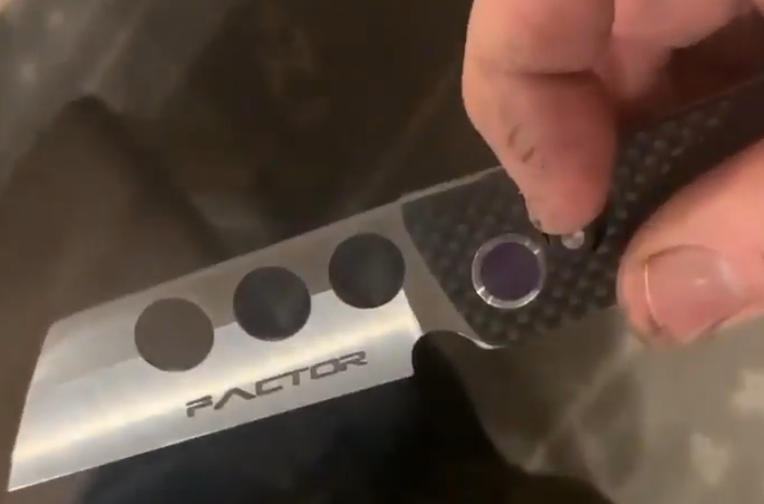
Oh, those 3 round holes? Well, that was an experimental design element that didn’t last long (you never want to poke at the aggro trademark attorneys at Spyderco—unless you’re Benchmade).
Between the 3 years when the first Factor prototypes emerged and the 2022 launch of the first generation Winterblade Factor, Bryan also kept very busy working on other project as well. You know the old saying, “Idle hands are the devil’s workshop”, right? Well, Bryan Winters is never in danger of having idle hands, as his workshop is always bustling with activity. Take a look below at just a few of the many, many projects he was developing simultaneously to the Factor Batch 1.

Top row, left to right:
- Ax Factor; Magnetic Slingshot Pistol; ElectroBlade; Light Saber
- Magnetic, No Spring, Solid State, Single Action OTF
- LED Factor; Factor RZR Exacto Knife; Magnet-Driven, Dual-Action, OTF Karambit
- Magnetic Button Lock Folder (aka Super Choil!); Micro Magnet-Driven OTF
- Magnet-Driven, No Springs, OTF Pen; Magnetic Switch LED Pen
And since the release of that first batch of Factor knives in 2022, over the past 3 years, Winterblade also developed and released these additional knives.

Top row, left to right:
- X-Folder; more Factor releases (B2 through B4)
- Mirage
- Veyron
- M-Fire
- Factor 8ight
- XRAY, Severn (2 batches)
- Fusion
- Darkfire OTF
This is only a partial list of the total offerings by Winterblade during that time. As I said, Bryan is a busy dude.
There was also this short-lived prototype, a natural for Winterblade. Bryan got the design from his garage when supply was abundant, albeit temporary, but sadly, his initial supply didn’t last past early spring. He called it the Winterblade Icicle. It even sported a special green pivot, although it was more decorative than functional, as the design was fixed in place. But I hear he’s contemplating a few design changes for later this year!

Introducing the Winterblade Factor B4 (Batch 4) Update
The Winterblade Factor has now gone through 4 batch releases. However, don’t believe for a minute that the Factor is merely a paper napkin design handed over to their OEM, Bestech, to interpret and build. Bryan Winters is a skilled engineer, designer and machinist, and he does all the custom machining of his initial prototype designs from the ground up for each batch release in his own workshop. And do not believe for another minute that this release is merely Winterblade’s 4th iteration of selling identical knives made by Bestech. Bryan is in a continuous state of redesigning and reengineering his work. As such, given the numerous technical updates applied to each batch release, these releases are actually versioning (V4) updates than basic batch (B4) releases.

I exchanged several messages with Bryan Winters about the details behind the Factor B4 release. He revealed a lot of insider information that I have never heard before, so perhaps I have a scoop or two to share! (I am the Knife Karen, your intrepid knife reporter!)
Per Bryan, the Winterblade Factor B4 was intentionally planned to be a very large release. This is because the Batch 4 release will be the only Factor launch for the next 1-2 years (that’s news!), so he intentionally went hog wild (his words!) by offering not 5, not 8, not 10, not even 12, but 13 new style variants. His offerings included a variety of model choices with a variety of:
- Blade materials:
- Magnacut
- Damascus
- Blade finishes:
- Stonewashed
- DLC
- Semi-mirror polished
- Handle finishes:
- Anodized
- PVD
- Laser Zebra (more on this in a moment)
- Handle textures:
- Smooth
- Micro-diamond milled
- Laser-etched (it has a different texture)
- Titanium handle colors:
- Natural
- Black PVD
- Ice blue anodization
- Light purple anodization
- Pocket clip materials:
- PVD-coated titanium
- Timascus
Additionally, 7 of the knife designs have Timascus pocket clips and pivot collars (the remaining 6 have plain pivots and PVD-coated titanium pocket clips). All knives are equipped with milled titanium handle scales. All knives have PVD-coated titanium Flip Levers, PVD-coated fasteners, and the Winterblade-exclusive, magnet-driven M-Lock.
The pre-order launched on February 23, 2025, and was 100% open & unlimited (customers were allowed to order more than 1 if they wished). The number of pre-orders received dictated how many knives Bryan needed to order from Bestech. And as it turned out, he received over 1,500 pre-orders! And as you may have surmised, the end of the pre-order period meant all the Factor B4 knives were sold out. If you didn’t already order yours, you missed it. Wa, waaa, waaaaa!
The scheduled delivery window for the B4 orders is expected to be between August and October 2025, although Bryan told me that it’s fairly likely that deliveries will be closer to October, given how many pre-orders came in.
So What’s Changed in the Batch 4 Edition?
Bryan told me that roughly 70% of the internals of the Winterblade Factor B4 have been redesigned and refined from the B3 edition. The main focus of the redesign was to create the smoothest and most side-opening, “automatic-switchblade-feeling” blade action possible, while obviously remaining a fully manual-opening knife. In case you wanted to know, the Factor is not a magnet-assisted-opening knife. Indeed, the magnets in the Factor internals are there to resist the blade from opening!
The key engineering and design update highlights of the Factor B4 release vs. previous Factor batch releases include the following:
- The Flip Lever of the Factor B4 had its opening geometry significantly redesigned for enhanced action. The new B4 Flip Lever, upgraded to PVD-coated titanium from the B3’s carbon fiber, has a longer, descending arm that swoops through the blade’s upgraded finger choil, redesigned to be fully rounded and deeper (across: 20.02 mm / 0.789″; deep: 9.47 mm / 0.373 “), causing it to literally throw the blade out of the closed position with both fine finesse and brute force. The goal with the redesigned Flip Lever / blade choil interface was to make blade deployment as intuitive and simple as possible. Apparently, a few comments received about earlier Factor versions indicated the Flip Lever action required a little more finesse to firmly deploy the blade. For some people, it seemed there was a bit of a learning curve needed to learn how to effectively use it and open the blade with a confident slam home. I have the B3 edition, and I can say that until I learned the trick, which is to put your finger on the handle spine in front of the Flip Lever opening and slide it down onto the lever rather than just pushing the lever down, it never really delivered the slam I wanted. But now with the B4 edition, that issue is completely solved.
- The Factor B4 sports a newly redesigned, double-magnet, configurable detent system. Inside the handle, just behind the rear of the Flip Lever cutout, are 2 magnets instead of the previous 1. These dual magnets more tightly keep the steel blade in place, serving as the knife’s detent system. And if you want, one of the detent magnets can be turned over to reduce the strength of the magnetic polarity, giving the user 2 levels of blade detent strength (Strong: north-south or south-north; Weak: north-north or south-south).
- The newly designed magnetic detent, along with the improved Flip Lever action, gives the Factor B4 a clearly snappier Flip Lever deployment action. And no wonder. The action internals of the new Factor B4 are very similar to the recently refined internals of the Factor 8ight (think of it as an XL version of the Factor).
- There are new blade steels and finishes offered with the B4 (more info on that down below).
- There are new handle finishes, too (more info on that down below as well).!
- The Flip Lever no longer lifts above the spine of the handle as it did on the Factor B3 knife. This change better protects the users’ fingers from contacting the exposed blade edge when the lever is up.
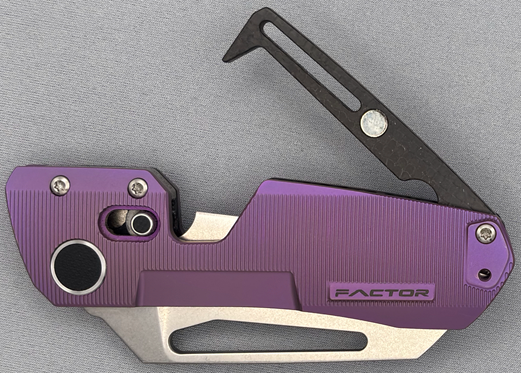
There’s another feature of the B4, one that is quietly left unadvertised, which I absolutely adore. Might this help you guess?
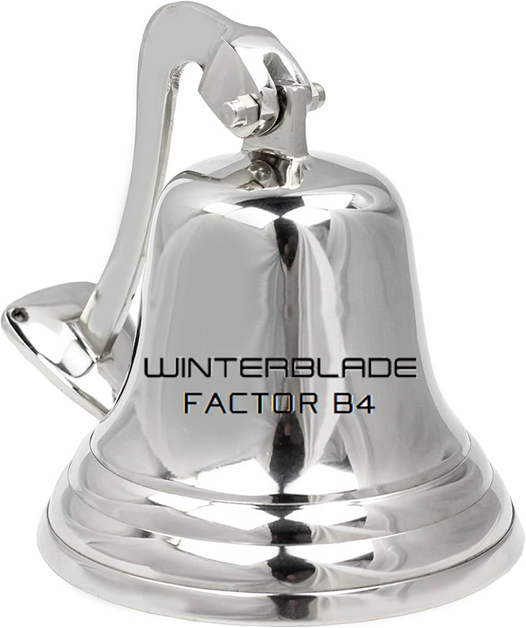
Yes! The Winterblade Factor B4 knife I am reviewing has a blade that sings, tings, & dings! What a beautiful sound to behold! I just love it!
I found that if I open the blade hard, the blade can ting like a tap on a silver bell! I believe Bryan was specifically working to make that happen with B4, but because of the many variables involved in getting this ring to consistently work (which adds up to higher manufacturing costs!), it’s a hush-hush, non-advertised feature. As a result, not all Factor B4 knives will likely have the blade ting. Still, many, if not most, will, to varying degrees of consistency (after all, the Winterblade Factor B4 is not a consistent ringing, singing Herman Knife, but then again, you’re not paying the incredibly steep price for the mid-tech Herman knife, either). The B4 review model I have tings with a hard reverse flick or when using the flop lever (I don’t think it’s as loud when using the Flip Lever, at least in my experience), and I have to hold the handle down low, next to the center of the blade opening slot so I don’t dampen the ting potential. Of course, YMMV.
A great tip that Bryan gave me was that if the ting stops happening, the pivot screw may have become slightly loose. Once tightened back down, the ting should return. He also said a loose body screw may also dampen the ting. Lesson learned: pay attention to your handle fasteners and you will enjoy the Factor B4 even more!
Oh, yeah, there’s one last thing. I uncovered why the Winterblade Factor knife has its unusual name and its unique design style. Bryan revealed that his Factor knife design was inspired by and named after his favorite bass guitar. He said, design-wise, he was going for the guitar’s overall ultra-modern, futuristic look. To be sure, this was his inspiration:
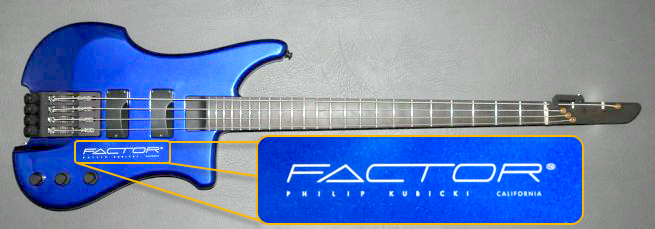
This gorgeous musical instrument art is the Philip Kubicki Factor bass guitar. Bryan loves the look of this bass guitar (he clearly has very good taste!). But this revelation brings up a new question: who other than an actual musician has a favorite bass guitar? Have we uncovered yet another secret about Mr. Winters? I have my own list of favorite bass players (and yes, these dudes are all from the classic rock era, but I am old, so I get a pass! Did you know I advised George Washington on what to wear to his first inauguration? Yup, that was me), but not a specific bass guitar instrument (I don’t know enough about these things to make a choice, but maybe one day!). I suspect Bryan may know who all these guys are, but at a minimum, he must assuredly know how to snap and pop fingerstyle, right?

From Top Left:
- Paul McCartney, Graham Maby, Gordon Sumner
- Geddy Lee, Jack Bruce, Peter Cetera
Oh, yeah, then there’s this guy:
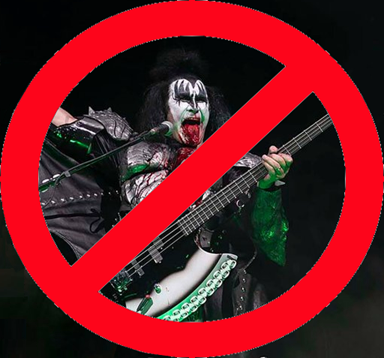
Um… No.
Details and Specs
The specific knife I am reviewing turns out to be a production sample prototype whose combination of features was not included in the final production offerings. This Factor B4 knife dons the super-cool Laser Zebra handle finish along with a stonewashed Magnacut blade and a pink / purple Timascus pocket clip and pivot collar. Gorgeous. I am swooning as I write this…

I always prefer blade finishes that show the beautiful steel in its natural state instead of wearing a color coating (in fact, unless the coating is genuine satin DLC, I likely won’t buy a knife with a coated blade).
During the official Factor B4 pre-order, the only knife sporting the Laser Zebra handle finish was equipped with a black, DLC-coated Magnacut blade, a black PVD pocket clip, and not a wisp of Timancus. That makes me very sad.
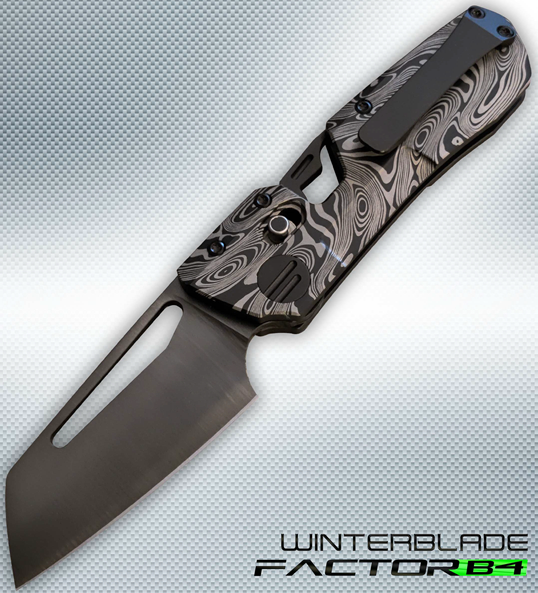
I definitely prefer the prototype version I have to review, despite the beautiful DLC blade on the official offering! What can I say? I am just a fool for the glamorous Timascus…
Blade
The blade on the Factor B4 is signature Winterblade. That blade shape is as iconic to the Winterblade brand as the Swoosh is to Nike. Yes, Nike is a bigger company today, but when the logo was first revealed in 1971, they were still a relatively small start-up known as Blue Ribbon Sports (aka BRS) and was mostly known as an importer / distributor for a brand of Japanese athletic shoes (woohoo.). They soon officially renamed their business after the Greek goddess of victory, Nike, who was associated with success in both military battles and athletic competitions. The Swoosh logo was supposedly designed to represent the wings of Nike, and thus her swiftness in movement and power in motivation. Yeah, sure. I always thought it was just a stylized checkmark. Whatever.
The blade design of the Winterblade Factor stands out for being unique in a pocketknife cosmos of sameness. That design identity makes the blade of the Factor knife, and thus Winterblade as a whole, an icon in the pocketknife industry.
Let’s get into the details of that iconic blade.
Blade Features
How does one describe the enigmatic blade design of the Winterblade Factor? For starters, it’s a full-flat grind, angular-shaped, almost cleaver-like blade with a very long, asymmetric obround, opening hole slot. It’s not exactly a Wharncliffe nor is it exactly a sheepsfoot, but something in-between.
There’s something that feels organic about the blade, yet at the same time, it leans toward being alien. If you will, the opening hole slot is the big, dark, alien eye with its significant, positive canthal tilt. The nearly-straight line blade edge harkens to the stark, yet angular alien features, and the color of the stonewashed blade is the same pallor of that matte, unearthly gray of extraterrestrial flesh.
The blade design is at first strange, potentially even offputting, but look at it. Spend a moment and look at it. Can you see it?
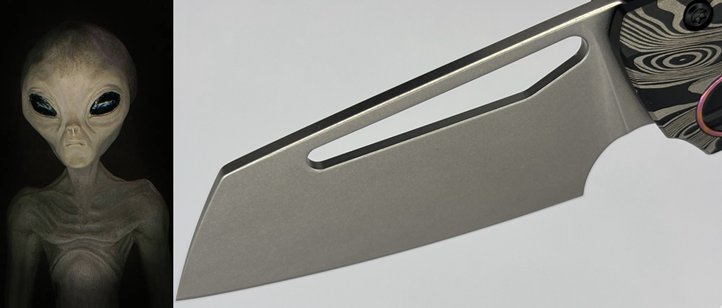
There’s something about the Winterblade Factor blade design that looks mysterious, fascinating, even beautiful, but also maybe a bit scary, intimidating and dangerous. It’s evocative of a lot of emotional reactions, to be sure.
Now don’t get me wrong. When I say alien, we’re not talking about a terrifying Xenomorph knife here. Rike already made that.

No way, Desiree. And despite the strong, angular correlations, we’re not talking about everyone’s favorite, lovably eccentric, robotic servant, Series 4000 mechanoid, Kryten 2X4B-523P, either.

Maybe the photos can’t convey the same impression made when you hold the Factor in your hand, where you can not only fidget with it, but closely look at it inside and out, really feel the ergonomics, experience its action, and really begin to understand what kind of impressions great design can invoke in a person.
This prototype Factor B4 blade has a stonewashed finish and sports a typical saber grind – about the only thing that is typical with this blade. There’s no swedge, no flats, no grind lines in between such regions, no fuller and no jimping. The only break from the pure flat face is the full blade height plunge grind line. The opening hole isn’t a simple, circular hole (move on, Spyderco attorneys!) or a rectangular slot. It’s a full-on, elongated, asymmetric obround slot (you try to describe it any better!). The blade just exists as it is, defiant in its uniqueness. It doesn’t have every feature possible, but what it does have, it does it BIG. And I dig it.
Opening Mechanisms
One of the key features of the Winterblade Factor is its unique Flip Lever bar blade deployment system. Check out the fascinating bit of knife engineering!
- The blade is held closed by the double-magnet detent system, set up by default so that both magnets are attracting one another, the strongest detent level configuration setup.
- The titanium Flip Lever pivots at its back, attached to a screw barrel, where a torsion spring holds the Flip Lever bar up in its resting place, firmly pressed into the polished Lock Bracket.
- On the front of the Flip Lever bar is an extended length, lower forward arm. At the bottom of that arm is a foot that touches the polished-smooth blade tang very close to its bearings.
- To deploy the blade, the user firmly presses down on the back of the Flip Lever within the cutout notch along the spine of the handle.
- The torsion sprint is compressed, and the downward pressure on the Flip Lever pushes the lever’s foot to ride along the large, smooth, rounded blade choil.
- The leverage of the minor movement upon the back of the Flip Lever just in front of the pivot amplifies the speed and power applied to the blade choil, close to its own pivot, thereby thrusting the blade open at considerable speed.
- Once the lever is released, the torsion spring returns the Flip Lever to its resting place against the Lock Bracket.
Cool, huh?
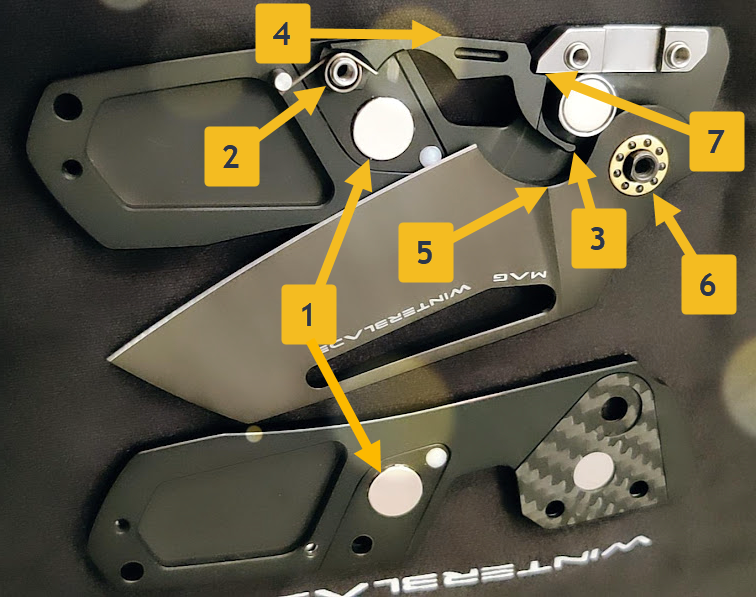
One of the best parts of this knife is the inherent fidget factor of the Factor Flip Lever blade deployment system. It’s addicting to play with because it works so well. A key improvement on the Factor B4 is the redesigned, extended forward arm of the Flip Lever bar and the fully-rounded, deeper blade choil. This combination of factors makes the Factor B4 a much mor enjoyable knife for blade deployment. Bryan likes to describe it as having the firing action of an automatic, side-opening knife but remaining a 100% manual knife, an important distinction for locations where automatic knives (aka switchblades) are banned. Additionally, if this appeals to you, there are 1.49 mm / 0.059” by 7.83 mm / 0.309” slots on both sides where you can install tritium glow vials.
But in case you think the B4 is only about the Flip Lever, you are mistaken, my dear reader! The aforementioned, hard-to-classify, blade opening hole slot (I still call it an elongated, asymmetric obround slot) not only has personality (even if to is a bit alien), but it’s a highly effective, very comfortable to use, well-designed alternative opening method. In fact, this is my primary blade opening method. The length of the slot can be used to do a slow but sure thumb roll-out. But I much prefer more snap than that (how else are you supposed to get that glorious ting?), so I am a big fan of the reverse flick with the Factor. Yes, you can use your index finger, but for me, I get the best snap by placing the tip of my middle finger in the middle of the opening slot and firing fast. That works flawlessly every single time. No exceptions. And the simplicity and joy of doing the reverse flick just gives you another option with the Factor friendly fidget factor.
Lastly, you can open the blade with an old-fashioned Spidey Drop, which is easily done, given how much of that tall blade is exposed outside the handle. But don’t bother trying that other, old fashioned folding knife opening method: the Shake. The dual-magnetic detent of the B4 is too strong.
Spine Features
There’s very few blade spine features to discuss. There’s no jimping and no crowning, but on the other hand, there’s no skin-rippingly sharp, 90° angled edge on the spine, either (cough, cough, Spyderco).

One great thing I will mention is that Winterblade designed the blade to have very nicely chamfered edges along the spine, the front angle, and along the opening hole slot perimeter. That itself is a great feature to have.
Choil
The finger / sharpening choil on the Factor B4 was a key part of the redesign from B3.

As mentioned earlier in the Opening Mechanisms section, the B4 choil was redesigned to be fully rounded and deeper by 2.63 mm / 0.104” to improve the Flip Lever action. That’s great for ergonomic usability for choked-up use. Luckily, there’s a negligible difference in the blade choil length between the B3 and the B4. My calipers measured the increase of the B4 choil length as a mere 1.76 mm / 0.069” compared to the B3. However, the blade length and the cutting edge difference between the 2 knives was an infinitesimally small decrease in the B4 of 0.23 mm / 0.009”, and that’s due to the slightly changed handle shape at the choil. As I said, especially from the user perspective, these length differences are negligible, if imperceptible. But the resulting functionality differences are significant.
The grind plunge line is correctly placed, running behind the center of the choil.
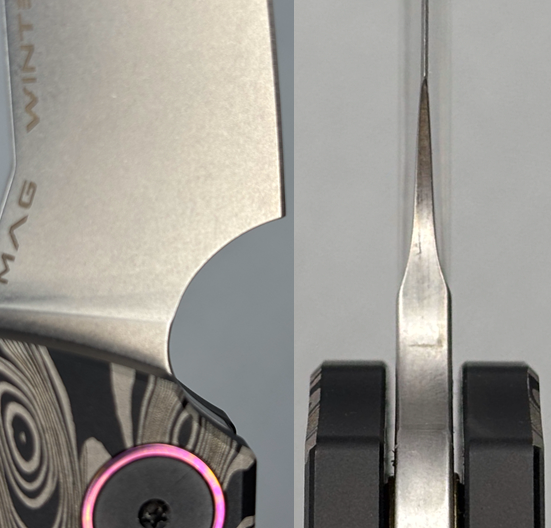
An added bonus is that the combination of the deep choil and the tall, thin blade offers the user a very long time of sharpenable use. That’s excellent design.
Geometry
There are several factors in the blade’s geometric design, such as its full-flat grind, the thin primary bevel (3°), supported by the slightly thicker blade edge bevel (19°), that make the Factor B4 a terrific and durable slicer.
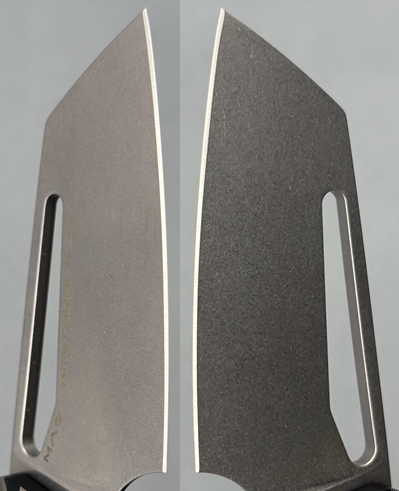
Add to that the expertise of Bestech, who provide perfectly even & symmetrical edge grinds along with excellent factory sharpening. Combine these features on an ultra-premium blade material possessing excellent toughness and stainlessness (discussed below) and you have a winning, enviable combination of top-tier factors for a top-tier pocketknife blade.
Blade Markings
The Winterblade Factor B4 blade markings are a bit enigmatic, but in a fun way. The show side is perfectly clean, devoid of any markings that would interfere with the aesthetics of this beautiful blade. It’s the clip side that is where the fun begins. That side of the blade is mostly clean of markings with 2 notable exceptions.
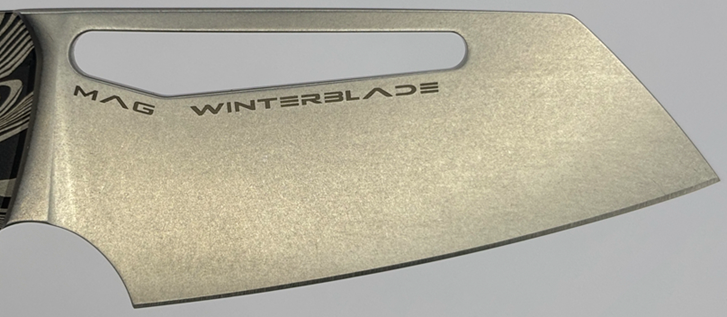
Underneath the Factor’s signature style oblong opening hole slot are 2 words. On the right side of the opening slot’s angle is the knifemaker’s brand name inscribed in its distinctive, custom font, “WINTERBLADE”. But on the left side of the angle is inscribed simply “MAG”. What is this?
As U no, I <3 abbr. They are efficient and fit well in tight spaces while still conveying their intended message. But what is MAG? I thought about what the abbreviation could mean and have a few ideas:
| MAG … | Definition | Assessment |
|---|---|---|
| Mag | Abbreviation for magazine or magnesium; also slang for ‘magnificent’ | Too ambiguous. |
| Magazine | A periodical publication containing articles and illustrations | Nope. That’s not it. |
| Magenta | A purplish-red color | That’s not it, either. |
| Maggot | A soft-bodied legless larva, especially that of a fly | That’s sick! |
| Magic | The use of spells, charms, or rituals to produce supernatural effects | This could be something, but why add it to the blade? |
| Magician | A sorcerer who wields great power by working in magic | OK, this describes Bryan to a T, but it’s odd for a blade marking. |
| Maggie | Rod Stewart’s mature girlfriend when he was a schoolboy | What? That doesn’t make any sense! |
| Magilp | A medium used in oil painting to alter texture or drying time | Wrong. No way. |
| Magister | A master or teacher, especially in ancient Rome or medieval universities | Makes sense for Bryan, but not for the blade. |
| Magisterial | Having or showing authority; domineering | This could make sense for the Factor’s place in the knife industry, but it’s too much of a brag for Bryan. |
| Magistrate | A civil officer or judge who administers the law | Bryan does lay down the law with the Factor, but hmm… |
| Maglev | A train or transport system using magnetic levitation | Very interesting – this could apply to the Factor B4, but… |
| Magnanimity | Generosity or nobility of spirit | Spot on for Bryan, and while the blade is indeed noble, this guess doesn’t grab me. |
| Magnate | A wealthy and influential person, especially in business | The Factor is a very influential knife, actually, but… |
| Magnesite | A mineral composed of magnesium carbonate | This isn’t even a metal. No way the blade is made from this. |
| Magnesium | A chemical element (symbol Mg) used in alloys and as a dietary supplement | This metal is way too soft to use as blade material. |
| Magnet | An object or material that produces a magnetic field | Sure, OK, that’s related, but the blade isn’t a magnet (or is it?). |
| Magnetism | A physical force of nature that causes certain objects to attract or repel each other | I know the blade is affected by magnetism, but not sure this fits… |
| Magnetite | A magnetic mineral form of iron oxide (Fe3O4) | This isn’t a metal, either. Not a chance. |
| Magnetosphere | The region around a planet dominated by its magnetic field | The magnetic field around the knife is not relevant to the blade material. |
| Magnetron | A type of vacuum tube that generates microwaves | Um… no. |
| Magnification | The process of enlarging the appearance of something | The Factor does have a knife design that’s clearly larger than life, but this isn’t it. |
| Magnificence | Splendor, grandeur, or impressive beauty | This is true for the blade design as well as the knife as a whole, but it’s what we’re looking for. |
| Magnitude | The great size or extent of something; | The significant impact of the Factor knife design on knife collectors & enthusiasts has many people taking notice, but this couldn’t be a blade marking. |
| Magnum | Denotes something of great power | There is great power in the Factor, but I don’t think this is the answer. |
| Magpie | A bird known for its chattering call and attraction to shiny objects | This bird may like the shiny mirror-finished Damascus blade of the Factor, but that is an irrelevant fact. |
| Magus | A member of a priestly caste in ancient Persia; a magician or sorcerer | Once again this could be Bryan, but not sure why it would be on the blade. |
| Maghemite | A magnetic iron oxide mineral | Once again, this isn’t even a metal. |
| Magma | Molten rock beneath the Earth’s surface | The Factor is definitely hot, but this seems excessive. |
| Magnetar | A type of neutron star with an extremely strong magnetic field | We already covered this at the start of this article. |
| Magalogue | A marketing term for a catalog in magazine format | What? Nonsense. |
| Magnacut | A proprietary stainless steel alloy optimized for knife making | Ah, yes! This is the way. |
I think we’ve figured it out. Bryan ordered the upgrade Magnacut from Bestech to be the B4’s default blade steel, so now it makes sense. Question resolved!
Magnacut TECHE
When I can get the ratings data for the knife steels I review (I primarily gather the data from the authoritative KnifeSteelNerds.com as available), I include it here in a section I call TECHE. What does TECHE mean? Well, you could look at the table below, but it stands for Toughness, Edge Retention, Corrosion Resistance, HRc Hardness Rating, & Ease of Sharpening. Clever, huh?
Note that all ratings but HRc Hardness Range are based on a scale from 0-10; Hardness is based on the Hardness Rockwell C scale, which technically is between 20 and 68.

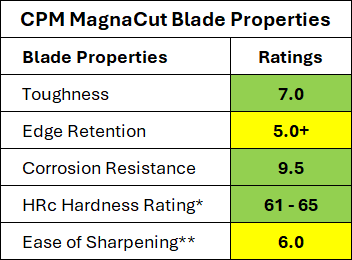
* HRc Hardness Rating data was gathered from Knife Steel Nerds, the best source for this data available.
** Ease of Sharpening data is not a rating produced on KSN.
+ Larrin Thomas, the inventor of CPM MagnaCut, himself rated his first batches of the steel to have an edge retention rating of 5 but has since stated he believes 5 was a very conservative rating. Of course, his latest steel, CPM MagnaMax, due out later this year, surpasses the edge retention rating of CPM MagnaCut. Can’t wait for that!
Blade Dimensions
I’ve got numbers. Let’s get into it.
Per my little calipers, the blade length measures 76.13 mm / 2.997″ while the cutting edge length is 64.49 mm / 2.539″. The blade height came in as 32.32 mm / 1.273″, the spine thickness is 3.12 mm / 0.123″, and the main bevel edge thickness is 0.38 mm / 0.015″. Cool stuff.
HRc Rating
Bestech reports the hardness of the new Factor B4 Magnacut blades comes in between 61-63 HRC, and that the DLC-coated versions were roughly 1 HRC point lower in hardness than the stonewashed versions. As such, expect the black blades to be at the lower end of the range, while the stonewashed blades should be on the higher end. Unfortunately, I don’t yet have a reliable way to test the hardness of blade steels on my own.
Sadly, I still don’t have the $32,000 cash lying about to pick up that sweet Mitutoyo model 810-521-13 HRc tester I want. Maybe next month.

Knife Body & Scales
I need to remind you that the sexy blade of the Winterblade Factor B4 is not the only factor that makes the Factor such a visually distinctive knife. Allow me to introduce you to the equally aesthetically impressive handle.
Handle
The handle design on the knife I am reviewing is called Laser Zebra, and you quickly see why.
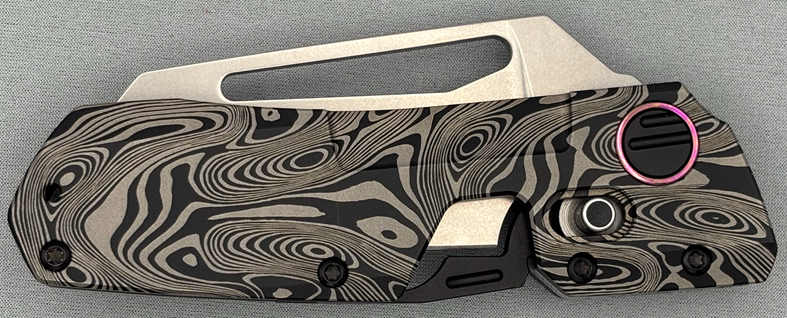
The bichromatic, matte black and titanium gray, hippie-trippy, psychedelic swirl design of the titanium scale finish begins its journey as a full, highly durable, black PVD coating. And as you might have guessed, sharks with frickin’ laser beams attached to their heads (or something like that) etched the intricate, consciousness-expanding, African-equine design into that black PVD, exposing the gray titanium underneath. Of all the Factor B4 handle designs, this is the one I asked to review (it’s really groovy, man! It was really high on my list — can you dig it?).
These Ti scales are more than just the psychoactive swirl. They are flat-milled with angular, sculpted cuts with matching, shallow-beveled edge cuts along the top of the handle at the rectangular, rounded-corners, a deep Flip Lever cutout as well as below the pocket clip area, done on both sides of the knife.

The scales have very nice, chamfered edges all around. The effect of the laser-etching, which cuts down a mere couple thousandths of an inch, leaves behind a super-fine finish texture that feels almost powdery / chalky, but it does enhance the grip. Both scales were milled with deep pockets in the rear for weight reduction.
The Laser Zebra makes for a uniquely striking, visual design on a pocketknife. Adding the coolio Laser Zebra scales to the already visually striking overall design of the Winterblade Factor knife just adds that much more to the unforgettable impression of this model. I love it!
Liners
Technically, there are no traditional handle liners on the Factor B4, given these scales are full, solid titanium. But that said, there is one thin layer of carbon fiber laminate (1) at the front of the clip side scale, surrounding the pivot hole (2) and the M-Lock magnet (3).

In addition, inside both scales are small, solid nylon cones (4), the pair of which serve as blade-centering bumper guides. According to Bryan, the detent magnets (5) tend to pull the blade to one side or the other, so these bumpers keep the blade inline. Lastly, we see the extent of weight-reduction milling (6) done by Bestech. These pockets are pretty deep, making the most out of the effort.
Here’s another look at the Winterblade Factor B4 internals from the bottom.

Locking Mechanism
The blade lock is another engineering invention out of the imagination of Bryan Winters. It seems that he creates a new blade locking mechanism with every new line of knives he releases. And we’re not talking about mere liner locks, frame locks, back locks or slip joints (and heaven forbid, the laughably antiquated Virobloc [aka ring lock]!). We’re talking in the league of the AXIS Lock, the Superlock, the RAM LOK, and the Shark Lock. But none of those locks are magnet-activated designs like the Winterblade M-Lock. In its appearance, the M-Lock appears to be just another crossbar lock, but this appearance belies a much more complex piece of engineering.
Comparative Locks
Let’s first take a quick, comparative look of “similar” blade locks. And by similar, I only mean that each of these locks secure the open blade by automatically inserting a locking mechanism onto a notch / ledge cut into the tang of the blade. In each of these examples, to unlock the blade, the user retracts the locking mechanism from the tang’s notch / ledge, allowing the blade to swing free and close. The key differences between these locks are the types of locking mechanisms used, how the mechanism is retracted, and the way the locking mechanism is internally deployed and held in place.
Please pardon the potentially reductive explanations here, but this article is already getting long (even for me!). But I do intend to explain the working differences between each type of lock. Also, to have the lock image orientation of the sample locks set in the same direction, some images were horizontally flipped.
AXIS Lock
The AXIS lock works by placing a pass-through crossbar, a thick pin that extends through each side of the handle and is equipped with thumb stud bar ends, which slides into the open blade’s deep, 90° stop pin ledge, acting as the open blade stop pin to securely hold the blade open. The crossbar is held in place by a pair of wire springs, 1 on each side of the bar ends on the knife’s liner (under the scales).
The spring uniquely resembles the 24th (last) letter in the Greek alphabet, the capital letter of Omega ( Ω ), thus earning its nickname, the omega spring. To close the blade, the user retracts the crossbar pin from the tang ledge via the thumb stud bar ends, allowing the blade to close. The closed blade is retained in place by the pressure of the crossbar pin held against the closed stop pin ledge, a softer hold on the blade, allowing the user to easily open the knife. The omega spring pressure provides the detent for the closed blade.
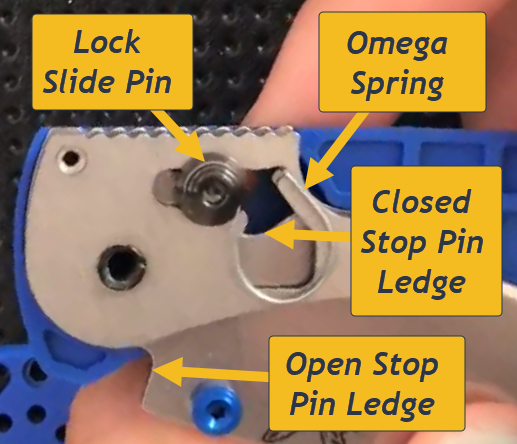
Superlock
The Superlock uses a long, lock slide rail, called the backspacer lock bar, equipped with a short, descending front arm that’s pushed forward into a cupped, open blade lock notch in the blade tang just below the open stop pin, firmly securing the blade open. The backspacer lock bar is constantly pushed forward by a coil spring held within a slot at the back end of the bar, pressing against a pin mounted into the handle liners.
Pro Tip: Be careful with this mischievous spring; because it wasn’t designed to be secured in place (why not, Snecx? Why?!), it has a nasty habit of suddenly leaping out of its slot and into another dimension of spacetime, where it shall never be found. (Don’t ask me how I know. Twice.)
To close the blade, the user retracts the backspacer bar by pulling against the jimped finger protrusion just above and behind the pivot, compressing the spring and removing the backspacer bar’s arm out of the notch of the tang. When the blade fully closes, the forward pressure on the backspacer bar’s descending arm presses onto a softer-angled, closed lock bar ledge, which provides the detent.

Shark Lock
The Shark Lock also uses a type of lock slide rail that is pushed forward onto a long, open blade ledge in the blade tang. The Shark Lock rail, secured with a pair of knife liner pins, and an open blade stop pin just ahead of the rail, locks the blade open. Like the Superlock, a coil spring (an unexpectedly long one!) constantly pushes the lock rail forward, enabling the lock to slip into place. Also like the Superlock, the spring is not secured in place, and although I have not yet serviced a knife using a Shark Lock, I have to imagine that this loosely held spring is equally liable to leap away without warning into the next spacetime dimension.
To close the blade, the user retracts the Shark Lock rail by pulling back against the finger protrusion (for quite a lengthy distance compared to the Superlock) until the rail is off the open blade ledge. When the blade is closed, the spring pushes the rail onto a shorter, softer-angled closed blade ledge where the Shark Lock rail acts as a blade detent.
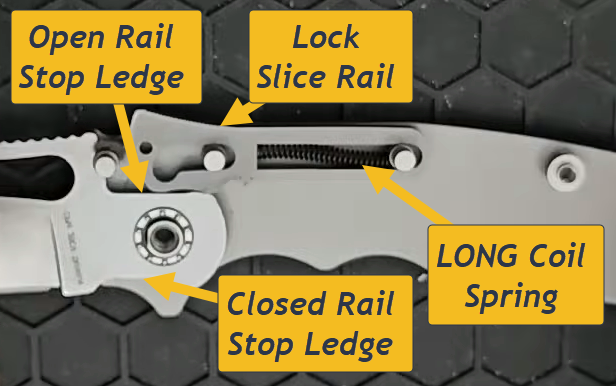
RAM LOK
The RAM LOK is sort of a hybrid of a crossbar and sliding rail lock. Like the crossbar lock, a pass-through, crossbar pin-like sliding block extends through each side of the handle, exposing its sliding block thumb stud (please pardon me if the terminology used here for the Microtech RAM LOK is not correct; there is absolutely nothing available on the Internet to help me prepare for this section). The sliding block is pushed forward onto the open blade slide ledge, and with the open blade stop pin in front of the sliding block, secure the knife in the open position. And like a sliding rail lock, the sliding block here is constantly pushed forward by a coil spring. But not just any ordinary coil spring, but a complete coil spring and guide pin assembly held in place by a liner pin .(Hey Snecx and Demko! This is how a folding knife lock’s coil spring should be secured! Sheesh.)
To close the knife, like the others described here, the user retracts the sliding block by pulling on either the side thumb stud grips or an exposed, flush-fit jimped grip on the knife handle’s spine (all part of the same sliding block). When pulled back, the sliding block is removed from the ledge, allowing the blade to fall freely. And similar again to the earlier locks, when the blade is closed, the sliding block is pushed forward onto the closed blade slide ledge, acting as a detent to hold the blade closed.
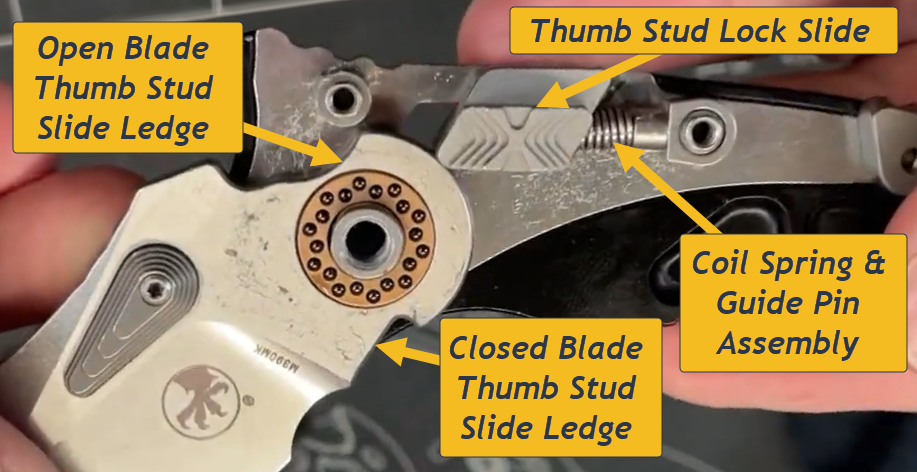
But beware! If you buy a Microtech knife equipped with the RAM LOK, do yourself (and your body’s limited supply of blood) a huge favor. Look to see if your knife’s RAM LOK looks like the image below when in the open position.
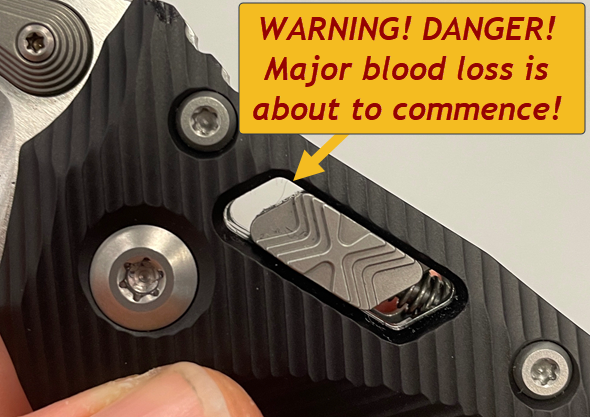
If you see a large gap between the end of the thumb sliding block and the front of the slide slot, carefully put the knife down, turn around, and briskly walk away. That gap equals blood transfusion time. This is indicative of the well-documented failure with the manufacturing of the RAM LOK when the lock was initially released. What you see here is evidence that the thumb slide block assembly has not fully engaged with the blade tang ledge. The sliding block is barely in contact with the tang’s opening slide ledge. All it takes is just a little bit of undue pressure on the back of the blade to cause the RAM LOK to unexpectedly release, just as you will unexpectedly release a lot of blood from your sliced-open hand. Stay calm and run like hell!
Such a beautiful lock design ruined by utterly crappy manufacturing. What a damn shame.
M-Lock Functionality
You’ve read about the rest, now let’s talk about the… Bestech-built knife lock as designed by Winterblade.
The preceding blade locks all use a form of mechanical spring action to push a locking mechanism, be it a crossbar, a sliding rail, or a thumb slide block, forward onto a ledge milled into the blade tang. Our friend, Mr. Winters of Winterblade, saw the idea and knew he could improve upon it. Instead of a spring, the Winterblade Factor uses 2 very strong magnets, one embedded in the clip side scale and the other attached to the Lock Button protruding through the show side scale (assuming a right-handed carry pocket clip setup). When the knife is fully opened, the large, Lock Button magnet is drawn onto the open blade ledge due to the attraction toward the embedded, matching clip side magnet, all of which firmly locks the blade in place.
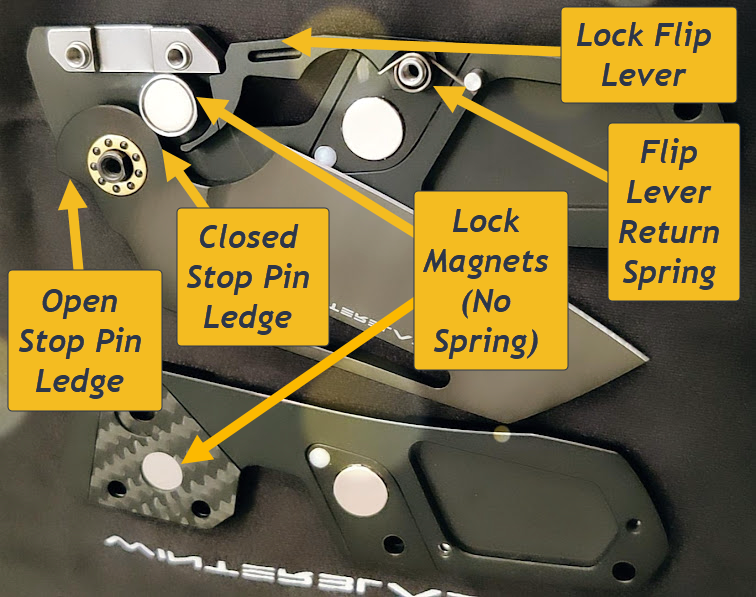
That large magnet, on the show side inside, is connected to the show side outside Lock Button. When you want to unlock the blade, you retract the Lock Button, which retracts the show side large magnet from the slip side embedded magnet, withdrawing the Lock Button magnet from the open blade ledge, allowing the blade to fall free.

Thanks to the excellent quality of the Winterblade design, the top-tier manufacturing quality of Bestech, and the knife’s use of magnets instead of springs, I can testify that there is absolutely no lock stick, no lock rock, no blade play (neither up-or-down nor side-to-side), no pivot lash, no detent double-clutch, no detent lash, and no pivot lash. Despite The Factor not having a detent ball, the dual magnets of the Factor B4 make for a very satisfying detent. The knife is snappy to open with either the opening hole slot or the Flip Lever. Take your pick and enjoy.
Pivot
As would be expected with clever knife design, the Factor B4 pivot offers these important features:
- It’s captive with a D-shaped pivot shaft that locks into place in the scale
- Along with being captive, a new, standard T8 socket on the clip side makes maintenance simple
- It’s a handsome devil with that PVD-coated, double-grooves (micro-fullers?) milled into the show side
- The pivot hosts caged ceramic bearings to ensure the blade runs as smooth as glass
- Due to the dual magnet detent, there is zero blade bounce!
- The cherry on top of this design aesthetic is the twin pink / purple Timascus collars (I adore this!!)
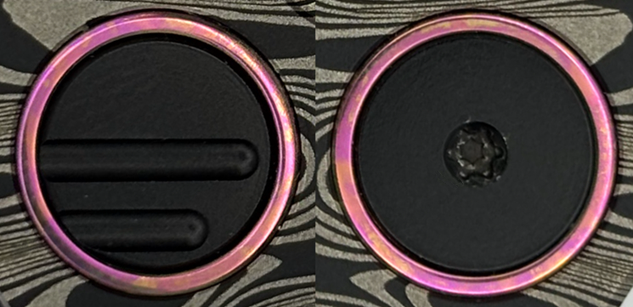
And, of course, due to the excellence in the design of the pivot and the handle internals, the blade is perfectly centered.
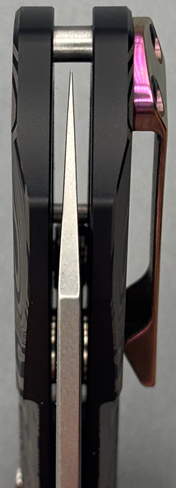
Detent
As mentioned earlier, one of the biggest new features of the Winterblade Factor B4 is the addition of a second detent magnet inside the handle scales.
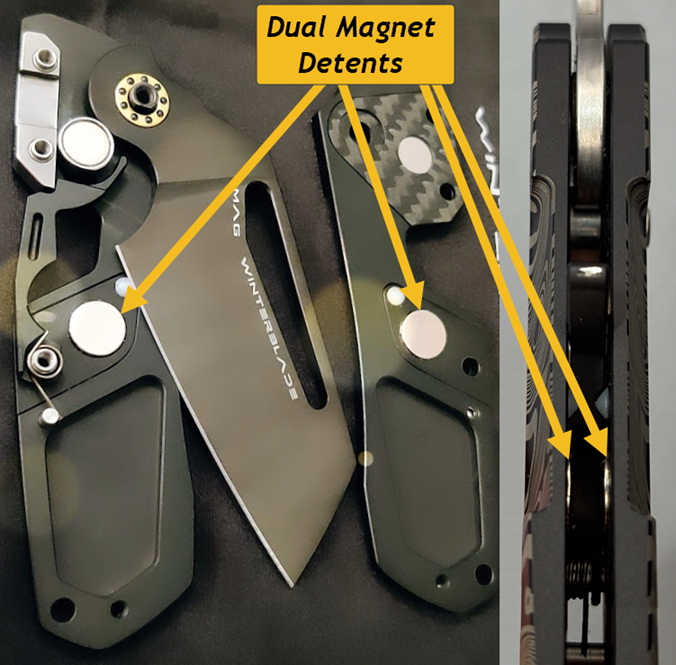
Winterblade’s new dual detent magnet system for the Factor B4 features a second magnet (duh! That’s what dual implies!) to add extra, magnetic retention strength to the Factor’s blade opening mechanism. Per Bryan, this is the strongest magnetic detent system he’s used on the Factor. And if for some bizarre reason, you actually like mushy blade detents (how odd of you!), Bryan has you covered. These scale-embedded magnets are adjustable (meaning you can turn over one of them to affect the overall magnetic attraction generated upon the blade). The strongest detent configuration is used by default on the Factor B4, providing the extra snappy deployment action I know I like.
Now let’s say you don’t like mush. In fact, you bloody well hate the mush so much that you beat it up into a pulpy … mush…, and you get some sort of peculiar, angry thrill from fighting the detent of your folding knife to just get the blade open, there’s also good news for you (although some counseling might help as well). I understand that the Factor B4 magnets are actually standard-sized, meaning they are 3/8″ wide x 3/32″ thick (identical on both sides). You could stroll over to your town’s local magnet store (what? You don’t have a local magnet store? Pity you) and pick up thicker, stronger magnets that can be as thick as 1/10”, potentially even 1/8″, to see if that satisfies your need for finger-torturing, detent fighting (I still advise a few counseling sessions as well). Bryan said that because the default 3/32″ thick magnets felt ideal to him, he didn’t test any thicker, stronger magnets, but what does he know? He’s just an engineer and knife designer.
All I can tell you is that the Factor B4’s detent action is excellent out-of-the-pouch, despite the lack of a detent ball mounted on a frame or liner. The new, stronger magnetic detent is in large part what makes the Winterblade Factor B4 such a fidget-friendly fun knife!
Stop Pins
The Factor B4 isn’t your everyday, mundane (aka normal) pocketknife. It doesn’t use standard stop pins like Grandpa’s knife does (assuming your grandpa owns a Civivi Vision FG or any of a million other folding knives out there that have actual pins that do nothing other than stop the swinging progress of the blade). Once again, Winterblade isn’t satisfied with mundane (thank goodness!).
The Winterblade Factor uses the top front, chrome-like, polished steel Lock Bracket as the opening stop, um… pin (I guess).
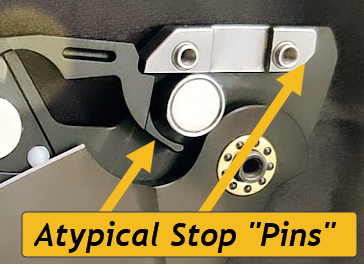
It’s actually the small, diagonal bevel on the lower front of that bracket where blade choil contact is made (more on that in a moment). And the closing stop “pin” is technically the Lock Button’s movable, large magnet, although blade choil contact is actually made against the lower arm of the Flip Lever (backstopped by that Lock Button magnet). The Flip Lever arm is there in the middle on purpose, of course. Nothing is done by chance on Winterblade knives. The Flip Lever’s descending arm needs to be set deep in the blade choil, for when the user wants to quickly open the blade, they press on that Flip Lever bar, which then pushes the lever’s descending arm (technically its foot) through the redesigned, deep, rounded choil, launching that blade straight out into that sturdy Lock Bracket (and if you do it right, you’ll likely be rewarded with that beautiful, steel-on-steel ting!).
Backspacer
The Factor B4 doesn’t offer a backspacer by default. It sports a single standoff at the end, which doubles as the mount for 1 of the 2 pocket clip screws. Winterblade lists a black, solid carbon fiber backspacer for the Factor on its Parts and Accessories page, but it’s sold out, so there’s no backspacer for you! Too bad, so sad.
Lanyard Mount
However, the existence of that lone backspacer is fantastic news for the last 3 dudes on the planet who care about lanyards: Jordan, Kent, and Owen. They can finally pull out their Type III 550 paracord and tie a snake, lark’s head (aka cow hitch) or diamond, knot, even add a skull bead because, you know, it’s “cool”. These goofballs are so obsessed with paracord that they’d try to tie a lanyard onto a Herman Knife if they could (sadly, for them, Hermans have neither rear standoffs nor any handle string holes for them, not that these silly boys would ever be able to afford such a knife, anyway). SMH.
Handle Dimensions
I have the data. Let’s share.
The thickness of the B4’s titanium scales measures 4.16 mm / 0.164″, the overall handle thickness comes in at 12.49 mm / 0.492″, and the closed knife handle height is 40.95 mm / 1.613″. The handle length is 107.41 mm / 4.229″, which gives the knife a blade-to-handle ratio 0.71. The fulcrum balance point of the open knife relative to the pivot, where 0.0 is balanced at the pivot, measures 16.98 mm / 0.669″ back down the handle. Yep, well, she does have a bit of a big titanium booty, huh?
Ergonomics
At first glance, with its bold and angular design elements, the Winterblade Factor may not strike you as a knife where user comfort was a design priority. And our survey said!: BUZZZ. Incorrect answer, but thank you for playing the game.
The feel in hand of the Factor B4 is surprisingly comfortable. The Laser Zebra handle scales have a powdery dry texture left over from the laser etching work, which gives the smoothly milled handle a non-slick, almost chalky feeling to me. (Is anyone else besides me old enough to remember blackboards, chalk sticks, and felt erasers in school? If you were a goody-goody [sycophant] student with your teacher that day, you’d earn the privilege of leaving the classroom to go outside and pound those chalk-dust-laden erasers against the school building wall to clean them out. However, you ended up getting everything all around you covered in that super-fine dust. When you were done, your hands were just caked with chalk dust. This is what the Factor B4 Laser Zebra handle feels like to me, and I didn’t have to kiss up to the teacher, either.)
In addition, all potentially sharp corners and edges on the handle have been nicely chamfered. Using the titanium Flip Lever to open the knife is a ton of fidgety fun, despite not having (nor apparently needing) any jimping. The lever is thick enough to feel fine on the finger when it’s used. The blade’s opening hole slot is also very well chamfered, preventing it from grinding off the nail surface of your middle finger, making it a joy to use. The Lock Button is smooth but sturdy. It doesn’t dig into your thumb, and you get a confident hold onto it, making blade release easy. In addition, the flat, broad, low-profile pocket clip doesn’t dig into the palm of your hand! Excellent!
The blade doesn’t have any jimping along the spine. When it’s done right (as on the gorgeous Viper Moon folding knife), jimping can make using a blade nicer. I also love crowned blade spines (also done very well on the Italian-made Viper Moon), but the Winterblade Factor doesn’t have that. That said, I believe such features would actually detract from and completely compromise the continuity of the overall design aesthetic of the Factor. I am normally very much a function-over-form kind of gal (despite my lust for a Herman Knife). However, I also love knives with svelte, soft edges and smooth forms. In the case of the Winterblade Factor blade spine, I think maintaining the integrity of its existing design is the right option, as its current design, sporting nicely chamfered blade edges (except for the cutting edge, silly!), already is very comfortable to use. The tight, cohesive aesthetic of the Factor is part of what makes this knife great.
But be careful. If you already have a reputation for always being the one to have a knife at the ready, or worse yet, are known for being the local “knife gal” (like me!) among friends and co-workers, don’t go out with only your Winterblade Factor in your pocket! Also pack another EDC knife, one you can lend out when someone asks, “hey, can you lend me your knife for a minute?” I say sure, and hand over the worst, old and rusted, dull as a bowling ball, piece of garbage, beater knife that I am embarrassed to admit I own. But it serves its purpose. They probably won’t ask again. And if they damage or even ruin the knife (which is what non-knife people always do!), I don’t care! I’ll ask them to buy me a replacement, but within a week, it’ll rust out and look just like the previous one just due to the humidity in the air! But I’m NOT lending out my special knives like my Viper Moon (or my Winterblade knives).
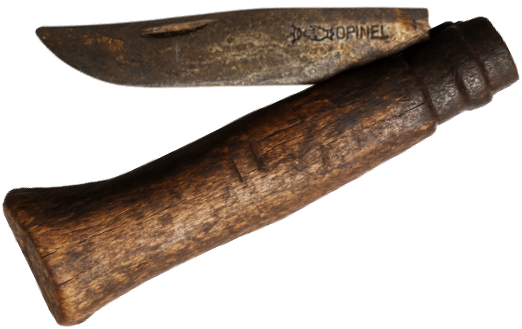
Another comfort factor built into the Factor B4 blade is that it possesses a deep, rounded choil that offers ample room to choke up for more precise control, but not endanger your delicate digits from a dreadful disastrous deluge of dark red drips.
Lastly, the Factor B4 has an extremely enjoyable opening action. I’ve reviewed some knives that had really beautiful design, but whose blades were needlessly difficult to deploy). The smooth simplicity of deploying and retracting the blade of the Factor is truly satisfying. I love it!
Hardware
The Factor B4 also has good hardware, and quite a bit of it! The internal design of the knife dictates the external necessity for numerous fasteners.

On the clip side of the handle, there are a total of 6 socketed hardware fasteners here. That’s a fairly high number for some knife critics. The show side is about the same, minus the captive pivot socket and the empty pocket clip hole that’s filled on the clip side pocket clip (did you follow that?).
I think it would be lovely if there was a way to hide some of these fasteners, at least on the show side (luckily the pocket clip on the Factor handle offers an ambidextrous mounting option, although then the show side for our Mollydooker friends may be different from the show side for the rest of us). Of course, hiding fasteners requires additional manufacturing and assembly work that costs additional money, and the Factor B4 is not an inexpensive knife as is.
Nevertheless, I give big kudos to Bryan of Winterblade for at least making the best out of a less-than-optimal situation. All the fasteners are T8s – every single one. One bit and done. Very nice. Also, for the B4 release, all the fasteners (including both sides of the blade pivot!) are black PVD-coated, minimizing their visual intrusion into the design presentation.
One glorious feature of this model of the Winterblade Factor B4 is the generous spark of elegance emanating from the milled, pink / purple, medium-deep Timascus pocket clip. It’s a solid chunk of expensive material; probably large enough to make 2 normal-sized milled clips.
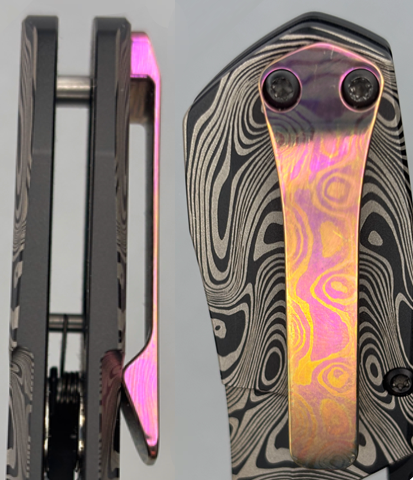
The length of that Timascus beauty is 52.20 mm / 2.055″, which gives the knife a clip-length-to-handle percentage of 48.6%, just under the 50% maximum that many prefer.
Weight
The Winterblade Factor B4 is no flyweight. It’s no petite petunia. It’s no willowy waif. The weight of our chunky little monkey is 122.90 g / 4.335 oz. That’s a bit of beefcake heft for a 7” knife with a 3” blade. But the Winterblade Factor was never intended to be a gossamer bagatelle. And I wouldn’t have it any other way. The Factor B4 does not use a Grivory handle (thank you, Bryan!); instead, it’s equipped with a thick pair of solid TC4 (the Chinese version of 6AI4V aka Grade 5) titanium scales. The pocket clip is not a piece of insubstantial, stamped steel. No, instead, it’s a nice, mesomorphic chunk of Timascus as well. And don’t forget that magnets weigh more than basic, diaphanous wire springs. And now with the B4, the Factor has even more magnets than before (which was the B3, which was half an ounce lighter, before the B4 added more magnets – are you following this?). All of that adds mass. And in any case, I like a little beef on those bones, if my meaning is making it to your mailbox. Suffice it to say that the Factor B4 is a substantial little knife.
Given the weight of the Factor B4, with a blade length of 76.13 mm / 2.997″, the weight-to-blade-length ratio comes to 1.61. That’s OK for me.
Design Considerations
Winterblade knives are not for design wimps. If you eat puffed rice cakes for the flavor, drink ultra-skim milk for the richness, or consider a big meal of hot water soup and Wonder Bread & mayo sandwiches to be delicacies, your tastes may not be bold enough to enjoy the spicy, unctuous design elements that are put into all Winterblade knives, especially in their flagship pocketknife, the Factor.
I won’t deny that the basic Winterblade design can be polarizing. Most people will not simply be ambivalent about it. Some will be immediately attracted like a magnet to its non-conformist, angular style, while others will find the design factors too far out of their normal knife comfort zone, a basic rectangular handle attached to a plain drop point blade. And that is a genuine shame—for them.
To be honest, when I first learned about Winterblade knives, I was immediately interested in their use of magnets in their numerous and clever locking mechanisms, not to mention their excellent knife action. The Factor was an immediate grail knife for me, even though I wasn’t initially captivated by its incredibly bold, visual design.
However, when I was fortunate enough to get my hands on the Winterblade Severn, the subject of one of my earlier, detailed Knife Karen reviews, I got the chance to do a deep, detailed examination of the knife. I was truly moved by the sophistication of the Severn’s design factors. Nothing was left to chance. Nothing was unconsidered or disregarded. The quality of the build, the smoothness of the action, the cleverness of the engineering, the quality of the materials, and the visual impact of the forward-thinking design factors drew me in. And when I learned more about the prolific creativity of Bryan Winters in both knife design and engineering, I became a genuine fan of Winterblade knives.
I believe that experience was an illuminating moment for me. I needed to not just look at a knife’s photos to judge it. I needed to hold it, to examine it, to open and close it, and to cut with it. I needed to find if there were little but important things that don’t come across in simple photos shown on my phone. With every Winterblade knife that I have had the good fortune to handle, indeed there is.
Ting!
As I’ve mentioned earlier, the Factor B4 sings like a bird ringing a bell that tings when it’s dinged! Can you imagine that? I spoke with Bryan, and I asked about the delightful ting I was hearing when I opened the Factor B4. He told me that he made an effort with the B4 revision to maximize the likelihood that it will produce that beloved ting. However, there are many factors that must be met before that ting consistently rings, including:
- Handle materials (stiff, solid metals are more likely to ting)
- Contact point of blade and locking mechanism
- Lock design
- Tight blade pivot tolerances
- Opening force applied to the knife
- Blade properties (shape, thickness, length, width, stiffness)
- Lack of dampening factors (soft bushings or detents)
All these factors contribute to how effectively a vibration frequency goes through the blade to generate that lovely song of steel. But to ensure the ting will always happen, the costs of the required precision manufacturing would increase, probably significantly. As such, the ting is not a promised feature on the Factor B4 webpages. But in reality, compared to previous models, the B4 model has a much better chance of ringing that ting, and if your earlier Factor model did ting, the B4 will probably ting better.
As part of my detailed inspection of the Factor B4, I have a theory of what causes the ting to ring. I noted that the polished Lock Bracket does more than look pretty. It’s a solid chunk of steel, securely mounted to the thick, solid titanium scales, that serves as the opening stop for the blade. And unlike a traditional, cylindrical pin, which has a very narrow contact point, the Factor’s Lock Bracket has a flattened, fully beveled angle in front that serves as a large contact patch. The larger, rigid contact patch of fast, steel-on-steel impact creates a more uniform impact, minimizing the blade bounce effect and maximizing the energy transfer into the handle and its refection back into the blade, thereby improving the vibration resonance and clarity, acting sort of like a tuning fork.
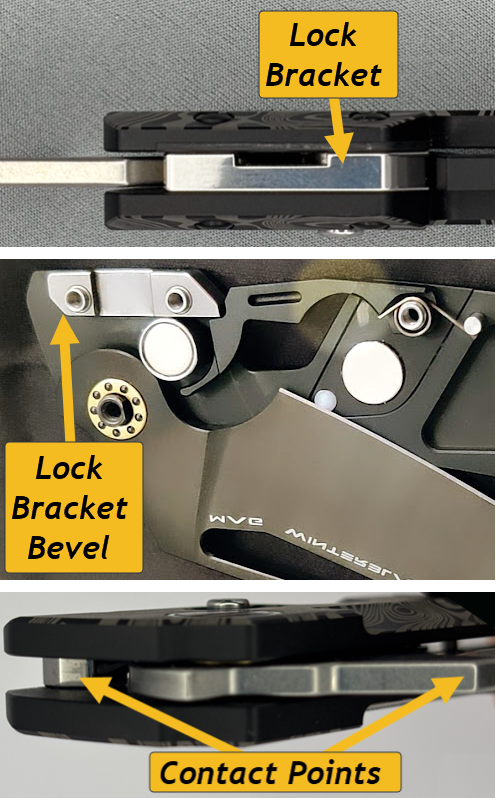
The ting-specific improvements to the Factor B4 were likely more precise milling angles on both the blade spine and the Lock Bracket to maximize perfect contact. Even if this theory is completely wrong (and this is always a solid bet), Winterblade directs Bestech to make this feature work to the best of their abilities, and it works very well.
Pro Tip: If you find the blade no longer offers that delightful ting, check the tightness of both the pivot and the handle fasteners. Having a screw loose is always a troublesome state.
Branding & Trademarking
Compared to many manufacturers, Winterblade is pretty subtle in adding its company identification on their knives.
Some knife manufacturers clearly have no idea how annoying large and verbose blade markings can be. For example, take a look at these 3 very disappointing examples. We have Benchmade adding their URL on the blade (!); Microtech adding a large logo and a ton of unnecessary text, and ESSE’s monstrously large logo that fills nearly 2/3 of the blade height (c’mon guys – this is completely ridiculous!).
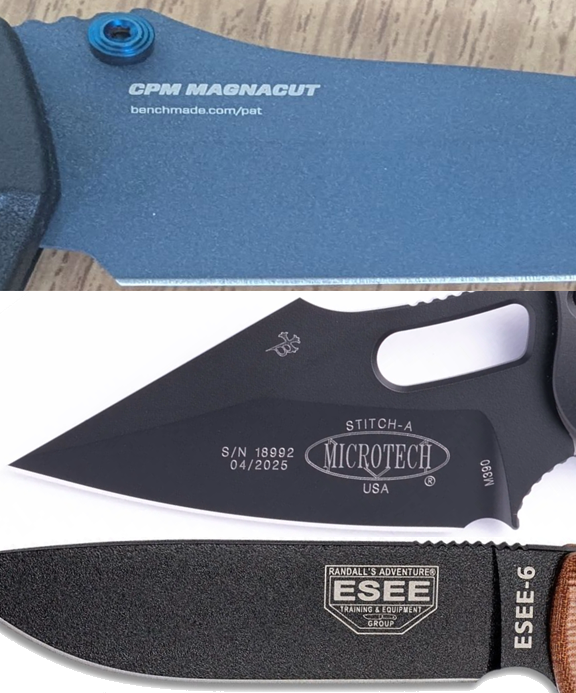
Bryan Winters once again bucks that all too common trend. On the Factor, the brand “Winterblade” is only presented on the clip side of the blade underneath the opening hole slot, and uses a small, highly stylized font which actually fits well with the knife’s overall futuristic, ultra-modern thematic design.
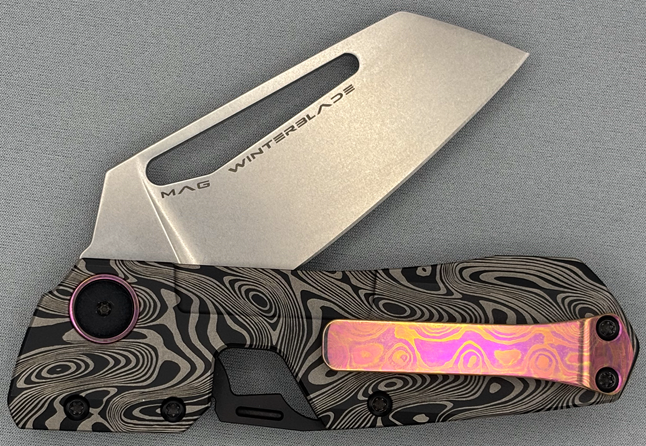
In addition, the knife model name is also usually added. Of the 13 Factor B4 knives listed on the Winterblade website, all but 1 have the model’s name added underneath the titanium pocket clip. The one exception? The Laser Zebra! I asked Bryan about that, and he said he “thought it might look too ‘busy’ amidst the zebra pattern.”
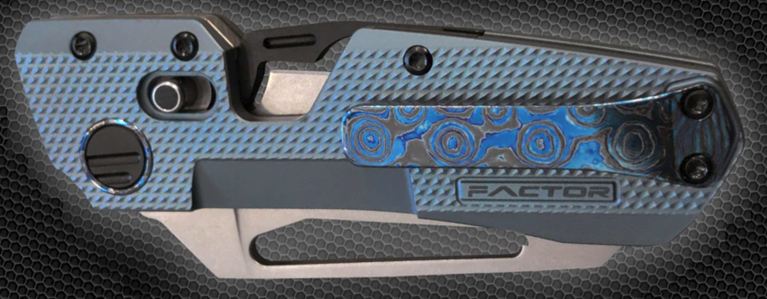
He added this about his philosophy of branding: “I don’t put logos on my designs for billboarding/marketing purposes. I actually really (really!) like the look of tastefully done print on knife scales and/or blades. The font, sizing and placement has to be ‘right,’ or the print can definitely detract from the aesthetics of the knife. It was purely an ‘artistic choice,’ in the beginning. I know that branding on knives is not to everyone’s taste, but in my humble opinion, many knives actually tend to look more plain and less professional (more ‘homemade’) without the ‘finishing touch’ of some well-placed branding.”
I agree. As someone who is vaguely familiar with the concepts of marketing directly to customers, a sterile product will ultimately be detrimental to brand recognition and growth. The product maker must understand that the product’s original customer will almost never be the only user of the product. If a later user discovers they really enjoy and appreciate the sterile product, but because they can’t identify a model name or its manufacturer, the chances are significantly lower that this person will ever become a future customer.
I appreciate the need for branding from a business perspective, but judicious subtly is always appreciated. When I see knifemakers add information inside the blade groove, on the underside of the backspacer, across the blade spine, visible on the blade only when it’s partially open, or something similar, this is really smart. But when brands carry on like those examples above, they either don’t understand the power of proper marketing, their knives don’t have a thematic design worth protecting, they let their marketing department override the designer’s vision, or they simply don’t care. It’s all rather pathetic in any of these cases.
Original Packaging
When I received this knife from Bryan, it was sent in a nice zipper pouch. The pouch doesn’t feel like the commonly used cheap, plasticky nylon pouches many other companies use (although those are better than the truly crappy, ultra-thin molded plastic inserts for paperboard boxes or even worse, those awful blister packs!). On the other hand, some companies seek to truly make a big first impression by spending a lot of money on overly fancy boxes with certificates of authority (CoA) made from etched metal or including mostly needless stuff like medallions, tools (you don’t need to send me a tool I already have, and if it’s a custom pivot tool, fix your flawed design and use a standard pivot access tool like a Torx socket!). The trouble with this is that most users will never do anything more with fancy-pants box, the metal CoA, and all the fancy-but-useless junk stuffed inside. But rest assured, my knife community friends, you paid for all that, whether you wanted it or not.
I don’t know what sort of box will be sent with new customer orders later this year (if any are, but I suspect there will be one).
The pouch is probably nylon, but it has a nicer feel, almost like canvas. It has silk-screened text on both sides, the brand name on one side and the company URL on the other (its use makes sense here).
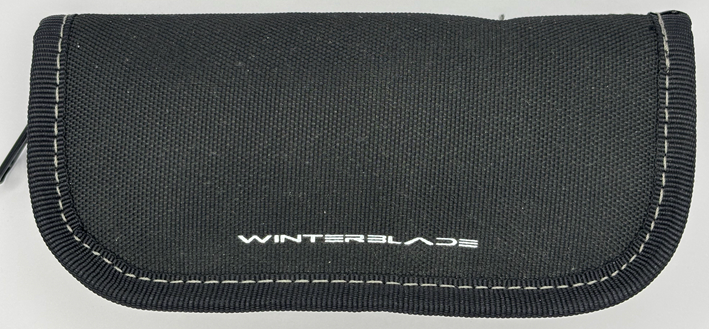
Inside the pouch is the typical black fleece lining to protect your lovely purchase. Bryan also includes a nice 200 mm / 7.81” square, black microfiber cloth.
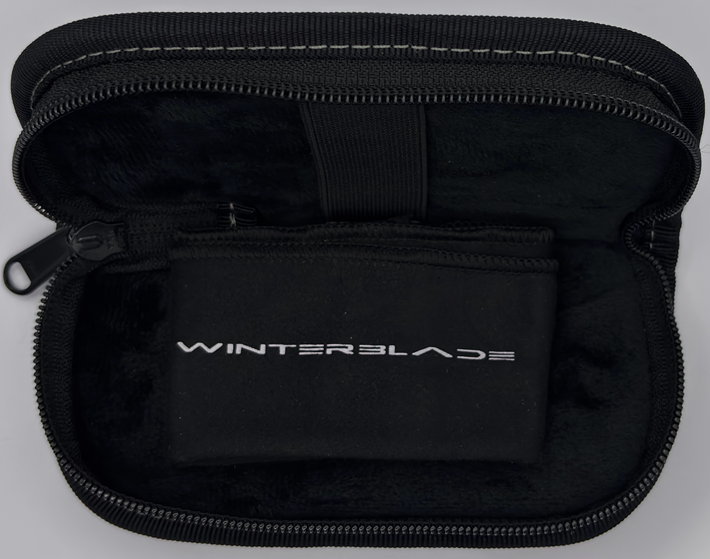
And for funsies, Bryan also includes some fun stickers and, wouldn’t you know, a fridge magnet (of course!!).
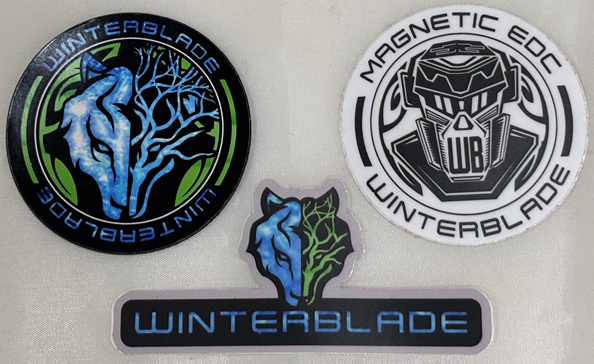
Knife Karen Nitpicks
OK, so if you read (or scrolled) all the way down here, you can probably tell I am impressed with the Winterblade Factor B4. This is not my first rodeo, and this is not my first Winterblade knife review. So is the Factor B4 a perfect knife? No. I have yet to see a perfect knife (or a perfect anything, for that matter). Is there anything to complain about? Ya, sure… sort of. There’s always room for improvements, right? So with those broad generalities stated, let’s get down to brass tacks and discuss all the truly awful things going on with the Winterblade Factor B4. And watch out! The Knife Karen is annoyed as all get out today! Grrr!
- The visual design of the Factor possesses great power. Some may not be able to bear its power and turn away in fear. But many others will understand the power, the reasons behind the power, the benefits of the power, and find great joy in possessing a knife with such great power! (Am I spelling this out for you, or do you need more vowels?)
- The laser-cut handle finish of the Laser Zebra feels a bit chalky, which reminds me of an old, chalk blackboard, nay fingernails scratching across that old blackboard, and that visceral memory still sends shivers up my spine (yes, I went to school back in the 1800s)
- The new Flip Levers now come with a pair of slots for mounting tritium vials, which is an interesting feature. However, using this assumes you boys are sure you want to keep a pair of special radioactive doodads, whose primary use is as a yield booster in modern thermonuclear weapons, regularly sitting in your pocket so close to your family jewels. But hey, they glow! Sounds cool.
- Even though I get the clear, bell-like blade ting most of the time while opening the knife, sometimes I don’t. Waaaaaa!
- I wish the Factor was just a bit larger, but then again, if it were, then it would be the Factor 8ight or the Severn.
- I’m disappointed that there’s no lanyard hole – Hahahahahah! OMG (whew)! I really make myself laugh sometimes.
Price
While price information appears now to be a moot point, given all the Factor B4 pre-orders have sold out, it’s my understanding that, depending on which of the 13 models you wanted, the prices ranged between $365 to $495. The ultra-premium knives made and sold by Winterblade are rather expensive, in case you didn’t know.
If you missed the opportunity to pick one up, there’s always the secondhand market such as BladeBinge.com and ArizonaCustomKnives.com, but be prepared to pay a hefty premium of 50%, 80%, or even 100%+, as Winterblade knives are top-tier, highly-desired, and exceptional quality knives sold in very limited quantities. And while the Factor B4 release was fairly large (1,500+ units is pretty big for Winterblade releases), Bryan told me that there won’t likely be another Factor release for the next 1-2 years. He’s got plans for other, important knife releases in the fire!
Pro Tip: Regarding buying on the secondary pocketknife market, do yourself a huge favor and think hard about where you buy high-quality secondhand knives, or even top-tier brands of knives labeled as “new”, on sites that don’t have explicit buyer protection and remediation policies against scammer sellers. These sites only want to facilitate sales and take their cut of the price, not do anything beyond giving lip service to offering thoughts and prayers to victimized buyers. They state that they believe their sellers are honest and have integrity (when so many do not; it makes you wonder what other odd beliefs these folks have). Those empty policies and hope-based protections are not close to being good enough these days. Such sites as eBay, Amazon, Reddit, BladeForums, and others may not even know (much less have control of) when their sellers peddle damaged, misrepresented or fake knives. Lastly, know that anything marked as new “Winterblade” knives are fake ads. Only the Winterblade website sells new Winterblade knives. You deal with these dodgy websites long enough and you are going to get burned.
Sorry if the news on the costs was a surprise, but a Winterblade Factor simply isn’t a commodity knife like a Harbor Freight Icon knife, my friends.
Verdict
The Winterblade Factor Batch 4 (aka B4) is, well, the 4th iteration of the Factor. Unlike some knifemakers who simply create more of the same when subsequent batches are released, Winterblade always adds design and engineering updates to their knives with each batch release. As such, the knife in this review is more accurately defined as the Winterblade Factor version 4 (v4). Bryan Winters, the founder, designer and engineer of Winterblade Knives, always looks for opportunities to optimize the performance and value of his products. He is also in a constant state of developing new ideas and designs he can apply to his existing or brand new knife releases. One look at the Winterblade Instagram page and you’ll see why he is literally the Thomas Edison of the knife community. He’s also a sharp-eyed marketer, excellent at growing brand and product awareness to the exceptional, top-tier knives and tools he creates. There’s little wonder as to why Winterblade has been so successful.
There are a number of upgrades to the Factor B4 compared to the B3 version release. In fact, Bryan stated to me that about 70% of the Factor B4 functional internals were upgraded in the current release. Just a partial list of B4 features includes:
- 1,500+ knives in 13 new models of various configurations offered
- Blade was upgraded with the following changes:
- Magnacut replaced M390 as the primary blade steel
- Coated blade finish upgraded from PVD to DLC. The Damascus blades have semi-mirror finish
- Finger choil was significantly redesigned from the B3 version to be fully rounded and deeper by 63 mm / 0.104”
- While not a promised feature, enhancements were made to improve the likelihood and enhance the quality of the much-desired opening blade TING
- Flip lever has undergone several changes:
- It’s now made of PVD-coated titanium
- Twin tritium glow vial slots added
- Lever can no longer be pulled up above the handle; better protecting the user from the blade edge underneath
- An extended-length, descending lower arm ending with a rounded foot was added
- The descending arm now sits between the blade choil and the Lock Button magnet closing blade stop
- The descending lower arm and the rounded choil, along with the upgraded magnetic detent (see below), significantly improve the Flip Lever opening action, popping out the blade with increased ease, speed and strength
- Several handle upgrades offered included:
- Detent has been significantly improved with the addition of a 2nd detent magnet, which allows for detent strength customization (the default is the strongest detent)
- Blade centering bumper guides added to both scales
- Micro-diamond handle texture available on 9 models
- New handle colors (Ice Blue, Light Purple) added
- Laser Zebra laser-etched finish added
- New Timascus pocket clip colors (Pink-Purple, Blue-Blend, Teal-Blend) added
- All pivot collars now made of Timascus (available on 7 models)
- Captive pivot now uses standard T8 socket
- All fastener hardware coated in PVD
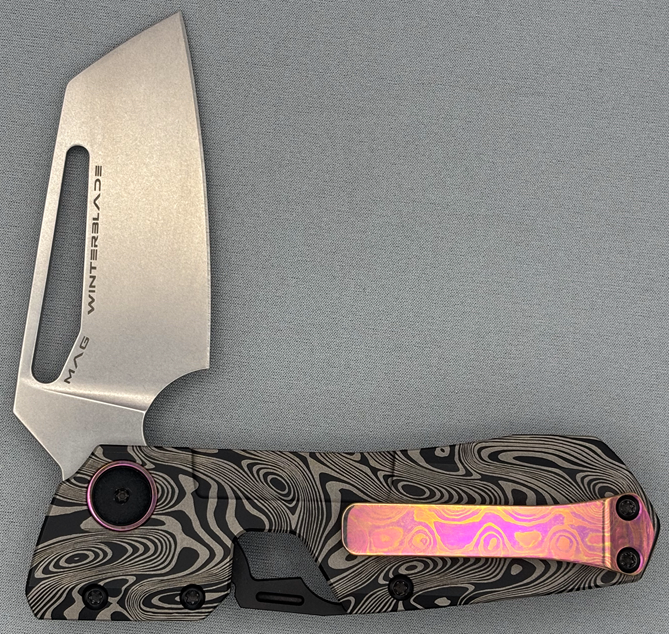
The Winterblade Factor B4 knife described and photographed in this review is a production-quality sample prototype that did not make it into the final 13 models offered, but it does represent the same quality and functionality as the knives sold in the pre-order.
Without any hesitation, I can say that the Factor B4 is a beautifully made knife, offering excellent blade action via either the improved Flip Lever or the wonderfully designed opening hole slot. And frankly, I really like the latest look (thank you, Bryan, for allowing me to see the unique Laser Zebra model! I love this psychodelia-style black swirls—straight out of the 1960s—handle finish! It was my favorite from first sight!). For me, I typically use the reverse flick with the blade’s slot using my middle finger, although with a little finesse, the index finger works as well. Of course, a slow roll with the thumb also works (and if you have good hand dexterity, a front thumb flick is a lot of fun!).
But most importantly, you must experience the new Flip Lever design of the B4. If you’ve tried using the Flip Lever on earlier versions of the Factor, you know that the easiest, most consistent way to use it was to slide your finger down the handle spine onto the lever to activate the blade deployment. With the Factor B4’s redesign, everything now is so much smoother. The energy used to press on the Flip Lever is far more efficiently transferred through the knife blade’s scoop-like choil to blast it open. As Bryan likes to tout, the ease and power of the new B4’s opening action is like experiencing a smooth, side-opening, automatic knife action yet remains a completely manual knife, ensuring customers who live in areas that arbitrarily ban switchblades can still enjoy the Factor B4. And just so you know, the magnets on the Factor don’t open the knife; in fact, they resist the knife opening!
And perhaps best of all, if you hold the scales low in the middle of the handle ‘s beveled cutout just above the opening hole slot, you’ll likely get that highly-desired, so pleasing, blade ting!
The Winterblade Factor B4 knife is a friendly, fidgety fun fanatic’s dream. The OEM, Bestech, built the Factor from top quality materials, based on the latest design and engineering directions created by Bryan Winters. It’s an excellent knife, and I am grateful to Bryan for enabling me to write this review.
In the pocketknife cosmos of so many, near-identical, run-of-the-mill pocketknives, the Winterblade Factor B4 is a unique magnetar, inextricably drawing you in to experience its power. If you get a chance to put your hands on this knife, it will really impress you. Enjoy! ![]()

